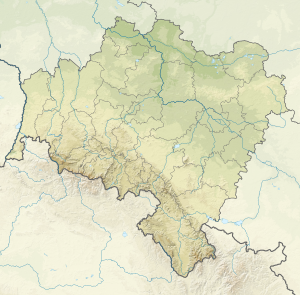Wielki Staw
|
Wielki Staw Big Pond |
||
|---|---|---|

|
||
|
The cirques of the small and large ponds on a topographic map |
||
| Geographical location | western Sudetes | |
| Tributaries | Bialy Potok | |
| Drain | Biały Potok → Łomnica | |
| Location close to the shore | Karpacz , Spindleruv Mlyn | |
| Data | ||
| Coordinates | 50 ° 45 '29 " N , 15 ° 41' 36" E | |
|
|
||
| Altitude above sea level | 1225 m npm | |
| surface | 8.32 hectares | |
| length | 576 m | |
| width | 198 m | |
| scope | 1.54 km | |
| Maximum depth | 24.4 m | |
The Wielki Staw (Big Pond) is the larger of two cirque lakes on the Polish side of the Smogornia (Mittagsberg, Czech. Stříbrný hřbet ). With an area of 8.3 hectares and a depth of 24.4 meters, it is the largest lake of glacial origin in the Giant Mountains.
location
The Great Pond is located on the northeast slope of Mittagsberg at an altitude of 1225 m , in the immediate vicinity of Mały Staw (Small Pond) and its glacier basin. Both lakes are located near the Czech-Polish border, approx. 6 km northeast of Spindleruv Mlyn (Czech Špindlerův Mlýn, Polish Szpindlerowy Młyn) and 6 km west-southwest of Karpacz (Krummhübel).
Emergence
In addition to the kars of the snow pits on the Hohe Rad , the glacier basins on the Great and Small Pond are the most distinctive cirques that can be found on the Polish side of the Giant Mountains. The kettle-shaped valleys on the eastern slopes of Mittagsberg, the steep slopes of which rise 180 meters on Wielki Staw and belong to the Smogornia avalanche path, were created by the activity of Ice Age glaciers, which left deep hollows at the valley floors, in which the water then collected to form mountain lakes . The valley-side end of the cirque is formed on the Wielki Staw by a rocky cirque swell (Karriegel) and a 30 meter high terminal moraine.
Water balance
The most important tributary of the lake is the Bialy Potok ( Weißbach ), the source of which rises in the west wall of the basin at about 1300 m . This mountain stream flows through the lake, forms its drain and flows into the Łomnica (Lomnica) at an altitude of 1085 m .
In winter and more than half of the year, the lake is covered in ice. The water is clean, clear and, as is typical for alpine mountain lakes, poor in nutrients. The water temperature does not exceed a maximum of 14 ° C even in the warmer months.
Flora, fauna and nature conservation
The Wielki Staw, the steep slopes of the glacier basin and the shore area are located in Zone I of the Polish National Park Karkonoski Park Narodowy (KPN). Due to the regulations, these areas are not allowed to be entered. However, the path of Polish-Czech friendship (Kammweg) leads along the top of the basin . The impressive view that is possible from here, however, compensates for all restrictions and those who want can experience the flora and fauna even more directly on the hiking trails on the neighboring Mały Staw , which belongs to the less strict protection zone II.
The edges of the lake are determined by subalpine vegetation such as Lapland willow , dwarf birch and mountain pine . The water provides a habitat for rare species, some of which are glacial relics such as Isoetes lacustris and Seemäuschen Otomesostoma auditivum , one to the order of seriata belonging Strudelwurmart . The mountain newt and brown trout as well as a melanistic form of the common toad also live here .
Web links
- A hiking route from Karpacz
- Underwater expedition on Maly Staw and Wielki Staw I (Czech)
- Underwater expedition on Maly Staw and Wielki Staw II (Czech)
Individual evidence
- ^ Raj A., 2008: Karkonoski Park Narodowy. Agencja Fotograficzno-Wydawnica Mazury na zlecenie KPN, ISBN 83-86565-32-2
- ↑ Rapala R., 2008: Zwierzęta w Parku Karkonoskim Narodowym. Karkonoski Park Narodowy, Jelenia Góra.

